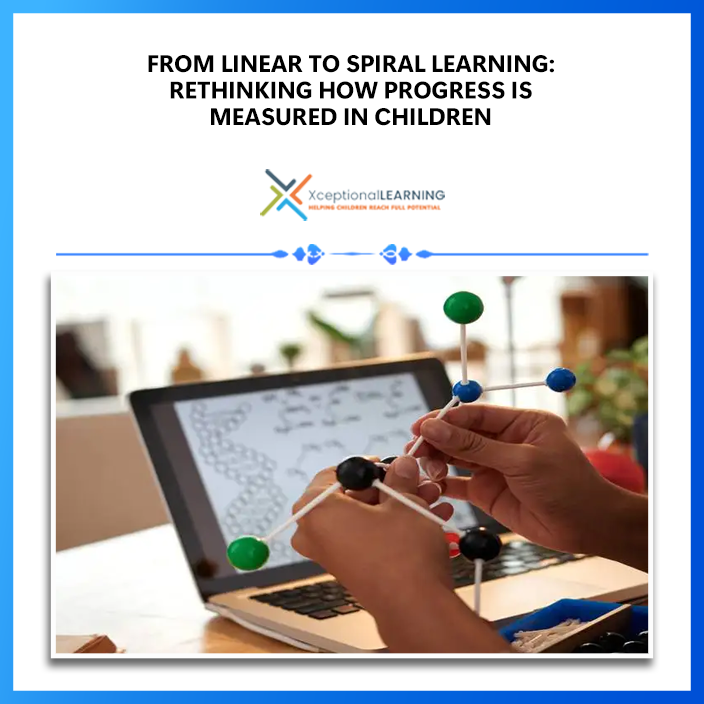From Linear to Spiral Learning: Rethinking How Progress Is Measured in Children
admin October 8th, 2025

Imagine you are teaching your child to tie their shoes. One day, they do it right— loop, swoop, and pull — and you are so happy they have learnt it at last. The next day, they’re struggling again, and we wonder why. Developmental knowledge tells us that they haven’t actually forgotten. Learning is not always a straight line.
For decades, we’ve measured children’s progress in therapy and education like a checklist — step one, then step two, then step three. But real development doesn’t work that way. Children grow in cycles. They circle back to old skills, reinforce what they’ve learned, and build on those foundations in ways that are anything but linear.
This is where the spiral learning model comes in. Instead of expecting children to climb a ladder of skills in a straight line, spiral learning acknowledges that progress may reevaluate, deepen, and expand with time. This approach has become particularly powerful in therapy and education for children with developmental, speech, and behavioral challenges.
Linear vs. Spiral Learning: What’s the Difference?
Linear Learning
- Follows a step-by-step sequence (like a checklist).
- Each stage is considered “complete” before moving on.
- Example: A child must master identifying letters before learning to read short words.
Spiral Learning
- Revisits earlier skills at higher and deeper levels.
- Assumes children may pause, return, and reapply skills in new contexts.
- Example: A child learns letters, tries words, returns to letter recognition with greater understanding, then builds longer sentences.
In therapy and education, spiral learning mirrors how children truly grow—not in straight lines, but in waves and circles.
Why Spiral Learning Fits Children’s Development Best
Children don’t learn like machines; they grow like trees—branching out, circling back, and reinforcing old skills in new ways. Spiral learning respects this natural rhythm.
Here’s why this mode of learning is beneficial to their development:
- Encourages deeper understanding instead of surface-level memorization.
- Reduces pressure on children to “get it right the first time.”
- Acknowledges regression as progress (a child may repeat a step but with new insight).
- Supports individualized growth, especially in therapy settings.
- Improves engagement, since skills are revisited in fresh, creative, and playful ways.
The Spiral Model of Measuring Growth
Traditional progress reports look at skills through a Yes/No lens. But spiral learning demands more flexible and layered ways to measure progress. Let’s explore a few ways in which this measurement can be facilitated:
- Focus on Milestones, Not Checklists
- Instead of asking “Has the child mastered this skill?” ask:
- Is the child showing emerging skills?
- Can the child apply the skill in different contexts?
- Does the child return to the skill with greater independence?
- Instead of asking “Has the child mastered this skill?” ask:
- Track “Loops of Learning”
- Every time a child revisits a skill, it’s not a failure—it’s reinforcement. For example:
- Week 1: Child says “ba.”
- Week 4: Child struggles but reattempts “ba.”
- Week 8: Child says “ball” spontaneously.
- Every time a child revisits a skill, it’s not a failure—it’s reinforcement. For example:
- Value Small Wins
- Count each smile, gesture, and attempt as progress, because consistency matters more than speed. For example:
- A child gripping a pencil correctly is progress, even before clear writing.
- Count each smile, gesture, and attempt as progress, because consistency matters more than speed. For example:
- Look at Transfer of Skills
- Measure growth by the application of a skill in new situations. For example:
- Counting blocks in class leads to later counting spoons at home.
- Measure growth by the application of a skill in new situations. For example:
- Observe Independence Levels
- Look at progress not just as accuracy, but as needing lesser and lesser of external support. For example:
- A child may start first with hand-over-hand help, then move on to prompting level, and finally become independent.
- Look at progress not just as accuracy, but as needing lesser and lesser of external support. For example:
Practical Applications of Spiral Learning in Different Areas
1. Speech Therapy
Linear model: First learn sounds → then words → then sentences.
Spiral model: Return to sounds multiple times while trying words, blending skills naturally.
Practical Example:
- Child practices “s” sound → attempts “sun” → struggles → returns to “s” sound with a therapist’s game → later says “sun” fluently.
2. Classroom Learning
Linear model: Teach addition → then subtraction → then multiplication.
Spiral model: Revisit addition while learning multiplication to see patterns.
Practical Example:
- The teacher introduces 2 + 2.
- Months later, while teaching 2 × 2, the teacher reminds students how multiplication links to repeated addition.
3. Occupational Therapy
Linear model: Hold crayon → draw lines → form letters.
Spiral model: Cycle between grip, hand strength, and drawing until skills integrate.
Practical Example:
- Child struggles to draw a straight line.
- Therapist switches to a clay activity to build hand strength.
- Later returns to crayon grip practice using a game.
- Eventually, the child draws lines more confidently and begins forming simple letters.
Tools and Strategies to Support Spiral Learning
- Digital Therapy Tools
- Platforms like XceptionalLEARNING and therapy tools like Digital Activity Book allow therapists and educators to revisit activities in varied forms.
- Same skill, different games.
- Builds engagement while reinforcing loops.
- Platforms like XceptionalLEARNING and therapy tools like Digital Activity Book allow therapists and educators to revisit activities in varied forms.
- Play-Based Learning
- Play naturally creates spiral patterns. For example:
- Building blocks: stack → fall → rebuild stronger.
- Pretend play: repeat roles but add new complexity each time.
- Play naturally creates spiral patterns. For example:
- Parent and Teacher Involvement
- Encourage celebrating repeated attempts instead of worrying about setbacks.
- Use journals or simple apps to track loops of progress.
- Multi-Sensory Approaches
- Present the same concept through sight, sound, touch, and movement to reinforce learning loops. For example:
- Teaching letters by tracing sandpaper letters (touch), singing alphabet songs (sound), and writing with markers (sight/movement).
- Present the same concept through sight, sound, touch, and movement to reinforce learning loops. For example:
- Flexible Assessment Methods
- Replace rigid testing with observation, portfolios, and ongoing feedback. For example:
- Instead of a one-time test on shapes, track how a child identifies, draws, and uses shapes in art or play over time.
- Replace rigid testing with observation, portfolios, and ongoing feedback. For example:
Practical Tips for Parents
- Encourage Repetition Without Pressure
- Reread the same story but ask new questions each time.
- Let children play the same game in different ways.
- Celebrate Attempts, Not Just Successes
- Applaud effort, even if results aren’t perfect. (“You tried saying that word again—great job!”)
- Create Flexible Routines
- Instead of strict steps, allow space for looping back.
- For example: If a child can’t button a shirt today, revisit tomorrow with playful practice.
- Instead of strict steps, allow space for looping back.
- Use Spiral-Friendly Materials
- Puzzle sets with varying difficulty.
- Digital therapy platforms with levels that revisit old skills.
Practical Tips for Educators
- Curriculum Design
- Revisit concepts in cycles, each time adding depth.
- Example: Teach fractions in Grade 3, revisit with decimals in Grade 4, and link to percentages in Grade 5.
- Revisit concepts in cycles, each time adding depth.
- Assessment Style
- Use portfolios showing progress over time.
- Replace “pass/fail” with “developing/mastering/expanding.”
- Group Activities
- Use projects where students repeat roles but expand responsibilities.
- Example: In a group presentation, a shy child first holds up a chart, later introduces the topic, and finally explains a part.
- Use projects where students repeat roles but expand responsibilities.
Practical Tips for Therapists
- Plan Loops, Not Straight Lines
- Build sessions that return to earlier activities with fresh twists.
- Example: A speech therapist reintroduces the same word set through songs, flashcards, and digital games.
- Build sessions that return to earlier activities with fresh twists.
- Track Cycles, Not Just Outcomes
- Record how many times a child revisited a skill.
- Note if attempts were easier, quicker, or more confident.
- Family Collaboration
- Educate families about spiral progress so they don’t panic during regressions.
- Share small wins frequently.
Case Study
Meet Vihaan (6 years old, speech delay)
- Linear expectation: Vihaan should move from sounds → words → sentences in order.
- Spiral reality: Vihaan often circled back to practicing sounds even after forming words.
Journey:
- Started with the “m” sound.
- Built to say “mama.”
- Regressed to just “m.”
- The therapist reintroduced “m” with songs and picture games.
- Vihaan later used “mama” confidently, then expanded to “mama come.”
Outcome: By honoring spiral learning, Vihaan gained confidence without being labeled as “stuck.”
The Future of Measuring Progress in Children
Spiral learning has the potential to redefine how schools and therapy centers track success. Instead of asking “Did the child achieve the goal?” the better question is:
- How many times has the child returned to this skill?
- What new depth is being added each time?
- How can we support the next loop instead of rushing forward?
- Is the child showing more confidence or independence with each revisit?
- Can the child transfer this skill to different settings (home, school, play)?
Conclusion
Progress in children’s learning is rarely a straight road—it’s a spiral staircase. Each loop may look like repetition, but in reality, it’s a deeper, stronger step upward. By shifting from linear to spiral learning, parents, teachers, and therapists can better support children’s natural growth.
At XceptionalLEARNING, we make the spiral journey of learning simple, visible, and empowering. With interactive games, guided sessions, and personalized digital exercises, children revisit skills, strengthen foundations, and build new abilities with confidence. By blending therapist expertise with smart digital tools, we make progress clear, measurable, and meaningful. Our Digital Activity Book and Specialized Therapy Services make it easy to track and celebrate growth. Families can connect with licensed therapists online, giving children access to personalized support anytime, anywhere. As the best therapy platform for therapists, XceptionalLEARNING combines innovation with expertise to guide every child’s spiral journey of growth. Contact us today to explore how we can support your child’s learning goals.

